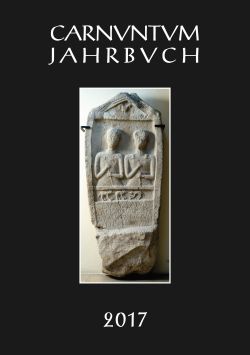 |
 |
Andreas Pülz (Schriftleitung)
Carnuntum Jahrbuch 2017
Zeitschrift für Archäologie und Kulturgeschichte des Donauraumes
Werner Jobst,
Rita Piras
S. 25 - 46 doi: 10.1553/cjb_2017s25
Verlag der Österreichischen Akademie der Wissenschaften doi: 10.1553/cjb_2017s25
Abstract:
Among the cult buildings uncovered at the Pfaffenberg mountain sanctuary, Temple II (Groller “building S”) differs distinctly from the other two Jupiter temples (Temple I/Groller “building C” and Temple III) in its layout and large dimensions. The building was already associated with the worship of the Capitoline Triad by the ancient historian E. Bormann, and has been identified as the “Capitol”. During the most recent investigations, two building phases were identified: The evidence indicated that construction phase I was precisely designed as a Tuscan temple, according to the rules of Vitruvius. Thus, the masonry of the older construction phase revealed the rectangular layout of a building consisting of a cella, two rectangular wings, and four columns in the pronaos; this structure is dated to Hadrian’s time. During construction phase II, the building was expanded by the addition of a porticus and two ancillary rooms, while the Phase I building was converted into a spacious cella with platforms on either side. These changes probably occurred around 200 AD. The interpretation of this structure as a temple dedicated to an “oriental” or Near Eastern deity (such as Mithras, or Jupiter Dolichenus), however, could not be confirmed.
2018/12/05 09:33:40 Object Identifier:
0xc1aa5576 0x003a1a1b
Rights:All rights reserved.For questions regarding copyright and copies please contact us by email.
Beiträge
Cristina-Georgeta Alexandrescu
Zu einigen Kult- und Votivdenkmälern aus dem nördlichen Teil der Provinz Moesia inferior
Werner Jobst – Rita Piras
Il Tempio II del Santuario di Giove sul Pfaffenberg/Carnuntum
Überlegungen zum Kult der Magna Mater und des Attis im Westen des Imperium Romanum
Julia Klammer
Limeswachtürme
Überlegungen und Untersuchungen zu Burgusstandorten am rechten Donauufer am Beispiel der Burgi
bei Mautern in Niederösterreich
Wolfgang Neubauer – Mario Wallner – Christian Gugl – Klaus Löcker – Alexandra Vonkilch –
Tanja Trausmuth – Erich Nau – Viktor Jansa – Julia Wilding – Alois Hinterleitner – Immo Trinks –
Michael Doneus – Geert Verhoeven – Nives Doneus – Hannes Schiel – Ralf Totschnig –
Roland Filzwieser – Vlad Sandici – Petra Schneidhofer – Tomáš Tencer – Manuel Gabler –
Sebastian Flöry – Jakob Kainz – Matthias Kucera – Agatha Lugmayr – Lisa Aldrian – Marie Kröhl –
Valeria Poscetti – Christine Markussen – Thomas Zitz – Sirri Seren – Ranko Manojlovic –
Timothy Saey – Marc Van Meirvenne – Franz Humer
Zerstörungsfreie archäologische Prospektion des römischen Carnuntum – erste Ergebnisse des
Forschungsprojekts „ArchPro Carnuntum“
Ausgrabungen und Funde
Izida Berger-Pavić
Dünnwandige tongrundige weiße/cremefarbene Ware („Eierschalenware“) aus Carnuntum und Siscia
Mit einem Beitrag von Z. Šimić-Kanaet (Siscia-Keramik), R. Sauer (mineralogisch-petrographische Analysen),
G. Schneider und M. Daszkiewicz (RFA)
Izida Berger-Pavić – Susanne Stökl
Neue Schlangengefäße aus der Zivilstadt Carnuntum. Ein Beitrag zur Problematik der Schlangengefäße
und ihrer Verwendung im Kult/Hauskult
Mit einem Beitrag von R. Wedenig und einem Anhang von R. Sauer
Lucia Clara Formato
Die Grabstele des Comatus aus Leithaprodersdorf
Eine bisher singuläre Darstellung eines autochthonen Auxiliarsoldaten mit Schwertbewaffnung aus
dem Carnuntiner Hinterland
Tafeln
|



 Home
Home
 Print
Print
 References
References
 Share
Share
